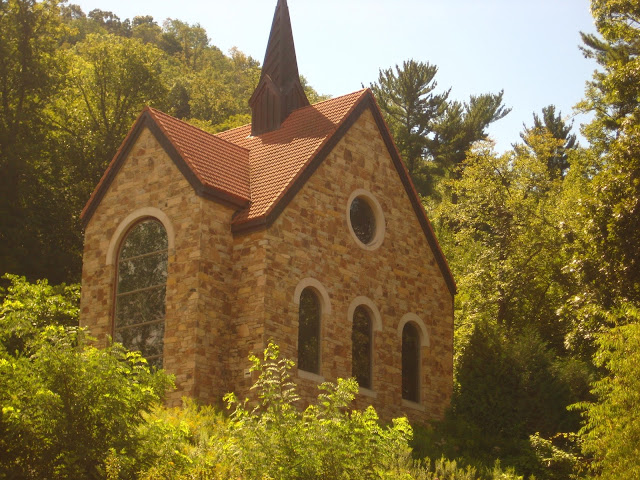Aug. 16-19
We left Merrillville, Indiana, a little before 11. I took a couple of wrong turns; we stopped for lunch; we waded through some road construction backups.
A trip that would have taken three hours, if we pushed it, took a little more than four. Not bad, because we aren’t in a hurry.
We crossed into the Eastern Time Zone somewhere in Indiana, so the clock said four when we checked in at the hotel.
We stopped just off the Ohio Turnpike in a town called Holiday City. I think they called it that because the city took a holiday and everybody is somewhere else.
A look at the Google Maps satellite image shows a few houses, but there are far more rooms for transients like us than for people who live here.
It has the look of one of those places that came into existence because there is an exit from a major highway. A child of our Interstate Highway System.
We stayed at Holiday Inn. There are two or three other hotels, a convenience store, a couple of gas stations, a restaurant called Wynn’s, which bills itself as a go-to restaurant and bar for locals as well as a stop for travelers. A few things—convenience store, storage depot, pizza shop—are all named for somebody called Hutch.
I like to brag that I make a great meat sauce, but would you really want to buy a pizza from somebody named Hutch? Well, maybe happy pizza in Cambodia, but a guy named Herb seems to have that market sewn up.
From what I can can tell, the town has a few other businesses, 20/20 Custom Molded Plastics, Chase Brass and Copper Co., and Adesa, which organizes automobile auctions.
And that’s about it, all by itself on the plains of Ohio.
I gather that it’s part of Jefferson Township, which doesn’t help much in finding the place. According to Wikipedia there are 26 Jefferson Townships in Ohio. Just remember it’s Exit 13 off the Ohio Turnpike.
Wednesday, the 17th, we were in western Pennsylvania, at another Holiday Inn. This one has a happy hour when drinks are a quarter. On Wednesday, they set out a buffet of hamburgers, so we had dinner there.
I had a couple of Goose Island IPAs for a quarter each. It was great fun.
The real surprise, though, came on Thursday. We drove across the Pennsylvania Wilds, the large reforested area full of game lands and state parks, to a place called Comfort Suites in Bloomsburg, Pa. I wasn’t familiar with Comfort Suites and hoped it would be better than Super 8.
It was.
I did, in fact, have a suite, which looked very much like the one at Holiday Inn—almost identical layout.
Bloomsburg itself is a charming college town, home to Bloomsburg University. It has brew pubs, a historic district, and looks reasonably prosperous.
It has a soldiers and sailors monument for the Civil War, as many old Pennsylvania towns do. There is also a large fountain, perhaps made of bronze, with what appears to be a pelican on top.
We arrived early, so we made a short tour of the town while the hotel got our room ready for us.
I had done a search and learned about Turkey Hill Brewing Co., a brew pub in the Turkey Hill Inn.
We found it and decided to go back there for dinner.
The menu is short, but offers more than the West End Ale Haus on Main Street.
Joanna had a modified pad Thai, minus the chiles. I had a seafood stew made with shrimp, clams, crab, and andouille.
I tried several small glasses of the house brews. My favorites among them were Revelation pale ale, which was close to an IPA, and A Midsummer Night’s saison.
The saison is made with some honey. I was skeptical, but found it surprisingly tasty.
It was a quick trip to Joanna’s house from Bloomsburg. We could have made it in little more than two hours, but decided to take a little detour at Delaware Water Gap, Pa., to visit an overlook for a different view of the Gap itself.
The trees have grown here and much has changed since I was a boy. Many of the rock cliffs are covered in foliage.
We used to see the profile of an Indian chief in the rocks. He’s probably still there, but under the cover of the trees.
We stopped at a welcome center so we could be properly welcomed back to New Jersey. We also picked up updated road maps. The one I had in the car was four or six years old.
My record for using outdated maps was set in 2009. I went through Maryland and Pennsylvania guided by vintage Esso maps.
The mileage on the car was a little more than 1,000 when we left on July 1. It has more than 8,600 miles on the odometer now.
It’s funny. I stepped out of the car to help Joanna take her luggage into the house. It felt as if we had been away only for a long weekend.
I’ve booked myself into La Quinta in Fairfield, N.J., for two straight weeks. I have a few days in September to kill before I leave for London on the 10th.
I haven’t decided what to do with that time. I could drive to Atlanta, or go to the New York hostel for a few days.
I expect that after two weeks in the same place, I’ll be ready for a change. But who knows?
Be well, all, and enjoy the scenery. It changes.
Harry





































